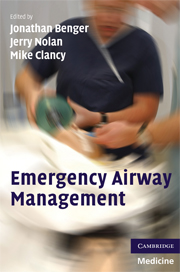Book contents
- Frontmatter
- Contents
- List of contributors
- Foreword
- List of abbreviations
- 1 Introduction and overview
- 2 Delivery of oxygen
- 3 Airway assessment
- 4 Basic airway management techniques
- 5 Indications for intubation
- 6 Preparation for rapid sequence induction and tracheal intubation
- 7 Rapid sequence induction and tracheal intubation
- 8 Pharmacology of emergency airway drugs
- 9 Difficult and failed airway
- 10 Post-intubation management and preparation for transfer
- 11 Emergency airway management in special circumstances
- 12 Non-invasive ventilatory support
- 13 The interface between departments and hospitals
- 14 Audit and skills maintenance
- Appendix: Emergency airway algorithms
- Index
1 - Introduction and overview
Published online by Cambridge University Press: 22 August 2009
- Frontmatter
- Contents
- List of contributors
- Foreword
- List of abbreviations
- 1 Introduction and overview
- 2 Delivery of oxygen
- 3 Airway assessment
- 4 Basic airway management techniques
- 5 Indications for intubation
- 6 Preparation for rapid sequence induction and tracheal intubation
- 7 Rapid sequence induction and tracheal intubation
- 8 Pharmacology of emergency airway drugs
- 9 Difficult and failed airway
- 10 Post-intubation management and preparation for transfer
- 11 Emergency airway management in special circumstances
- 12 Non-invasive ventilatory support
- 13 The interface between departments and hospitals
- 14 Audit and skills maintenance
- Appendix: Emergency airway algorithms
- Index
Summary
Objective
The objective of this chapter is:
to understand the purpose and scope of this manual.
Introduction
Effective airway management is central to the care of critically ill and injured patients. Competency in assessment and maintenance of the airway using basic airway manoeuvres first, followed by advanced skills such as rapid sequence induction of anaesthesia and tracheal intubation, are core skills for doctors who treat seriously ill or potentially ill patients. In the UK, this typically involves the specialties of:
anaesthesia
emergency medicine
intensive care medicine
acute medicine.
The location for emergency airway management is usually outside the relatively controlled environment of an anaesthetic room, most commonly in the resuscitation room of an emergency department, but sometimes in a variety of other in-hospital and pre-hospital settings. Emergency airway management can be difficult and challenging: it requires individuals to work in relatively unfamiliar environments under conditions of stress and uncertainty, and where the principles of elective anaesthesia need modification. Information is often incomplete, normal physiology deranged, and opportunity for delay is infrequent. The problems intrinsic to these patients, such as an unstable cervical spine, poor cardiorespiratory reserve or profound metabolic dysfunction, must be anticipated and surmounted.
Emergency airway management is not simply an extension of elective anaesthesia, and specific training is essential to safely treat this challenging and heterogeneous group of patients. Individuals must practice within the limits of their own competence and work collaboratively with experienced clinicians from several disciplines to ensure patients receive optimal care (Figure 1.1).
- Type
- Chapter
- Information
- Emergency Airway Management , pp. 1 - 2Publisher: Cambridge University PressPrint publication year: 2008



